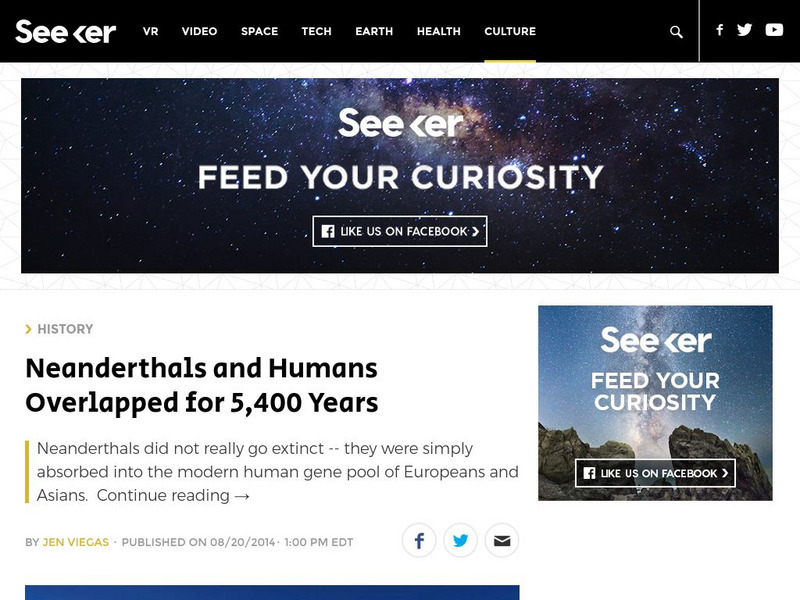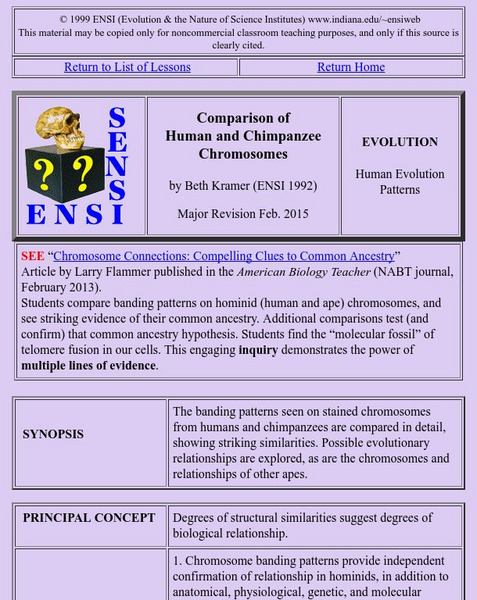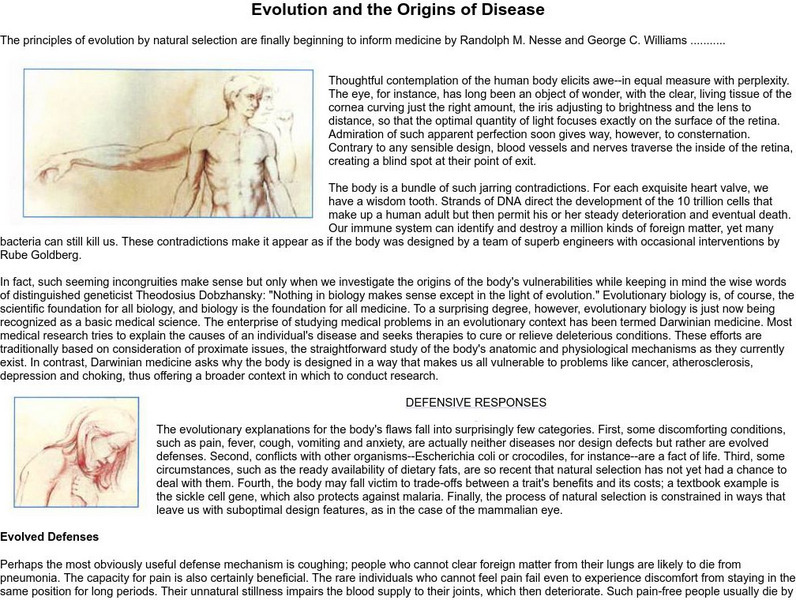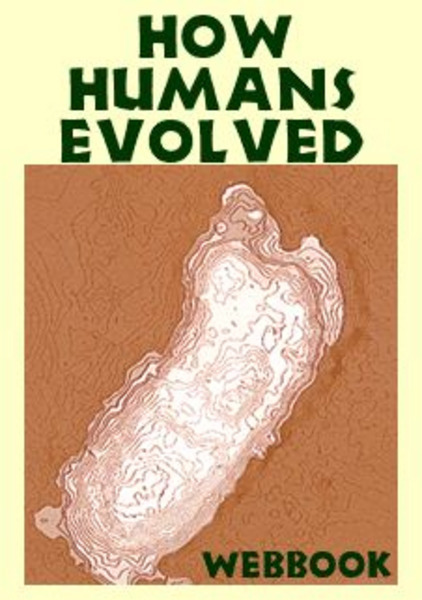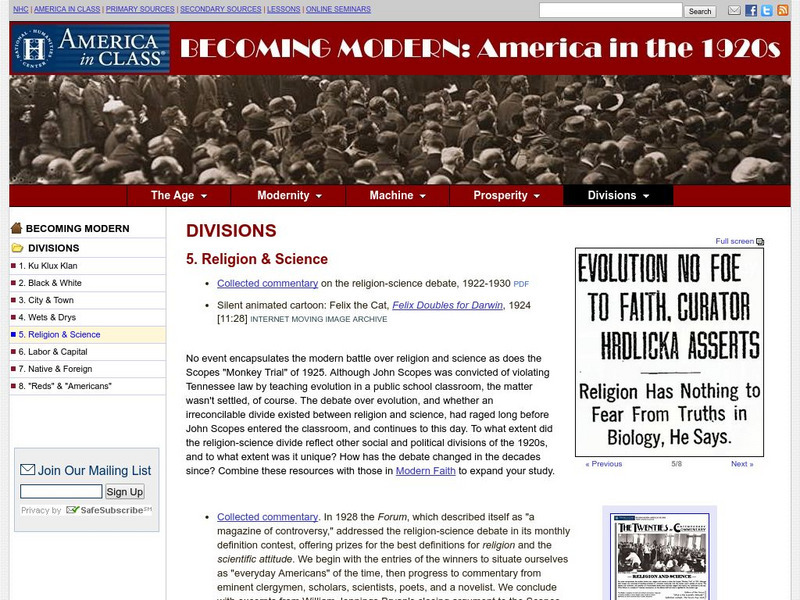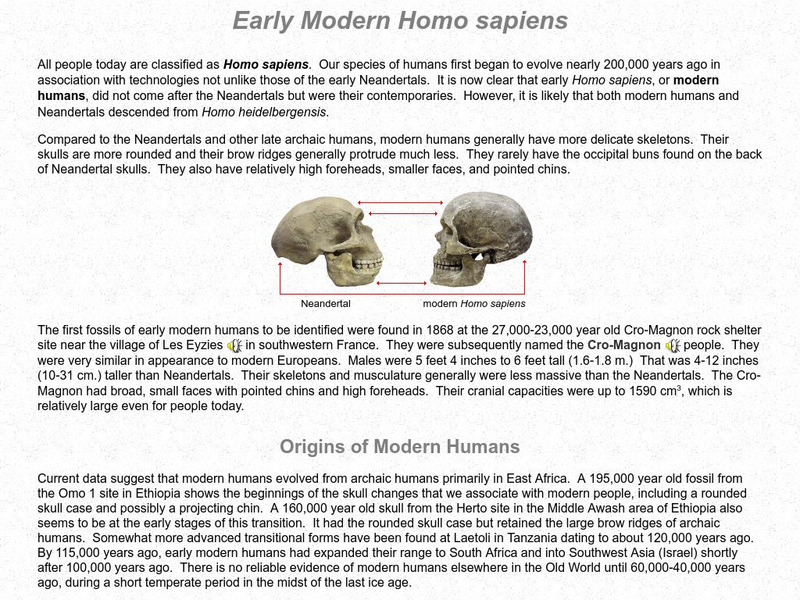American Institute of Biological Sciences
Action Bioscience: Mitochondrial Dna Clarifies Human Evolution
Deep mitochrondrial DNA research has revealed information identifying the origin of modern humans, the founding population, a general date of humans evolving, and the migration of these humans across the planet. Read further to discover...
Other
Becoming Human: Evolution and Human Uniqueness
This is Chapter One from "Becoming Human: Evolution and Human Uniqueness," by Ian Tattersall. This chapter presents recent findings about the art and artifacts of early humans, and what those artifacts tell us about the intellectual...
Seeker
Seeker: Week of 8 25 14: Neanderthals, Humans Overlapped for 5,400 Years
Learn why recent discoveries are causing scientists to rewrite the timeline of modern humans and Neanderthals.
Indiana University
Ensi: Comparison of Human: Chimpanzee Chromosomes Lesson
This is a great lesson plan that combines Karoytypes and evolution. Students will recognize that the chromosomes of chimpanzees and humans are remarkably similar, then correlate that to their evolutionary relationship.
American Institute of Biological Sciences
Action Bioscience: Mitochondrial Dna Clarifies Human Evolution (2001)
DNA of the mitochondria has most commonly been used to construct evolutionary trees. New field of population genetics hopes to resolve important questions in migration theories that involve Aboriginies in Australia, North America, and...
Other
St. Bonaventure University: Evolution and Origins of Disease
Learn about natural selection and the defenses that are built in to the human body. Topics include pathogens and the evolution of defenses.
W. W. Norton
W. W. Norton & Company: How Humans Evolved
This provides access to a webbook about How Humans Evolved. The following topics are covered: (1) How Evolution Works, (2) Primate Behavior and Ecology, (3) The History of Human Lineage, and (4) Evolution and Modern Humans. Each chapter...
National Humanities Center
National Humanities Center: America in Class: America in the 1920s: Religion & Science
The National Humanities Center presents collections of primary resources compatible with the Common Core State Standards - historical documents, literary texts, and works of art - thematically organized with notes and discussion...
TED Talks
Ted: Ted Ed: The Evolution of the Human Eye
The human eye is an amazing mechanism, able to detect anywhere from a few photons to a few quadrillion, or switch focus from the screen in front of you to the distant horizon in a third of a second. How did these complex structures...
CK-12 Foundation
Ck 12: Earth Science: Evolution, Plate Tectonics, and Climate Change Study Guide
[Free Registration/Login may be required to access all resource tools.] Summarizes the key points about three theories in Earth Science: the theory of evolution, the theory of plate tectonics, and the theory of climate change due to...
PBS
Pbs Learning Media: Laetoli Footprints
This Evolution video segment describes how the famous track fossils known as the Laetoli footprints might have been formed and what they can reveal about the creatures who left them.
Other
Big History Project: Chapter 4: Humans
Big History Project takes a comprhensive look at humans. From evolution to migration, agriculture to complex civilizations, students and teachers will be intrigued by this interactive learning module.
National Humanities Center
National Humanities Center: America in Class: America in the 1920s: Felix the Cat
The National Humanities Center presents collections of primary resources compatible with the Common Core State Standards - historical documents, literary texts, and works of art - thematically organized with notes and discussion...
BBC
Bbc: Mother of Man Lucy
Article discusses the importance of Lucy to the theory of evolution and her bipedalism form of locomotion. Archived.
Khan Academy
Khan Academy: Human Impact on Animal Populations
Multiple choice practice questions over evolution and population dynamics and the human impact on animal populations. Passage 2.
National Humanities Center
National Humanities Center: Teacher Serve: The Rise of Fundamentalism
The National Humanities Center offers an essay on the definition and discussion of generic fundamentalism and historic fundamentalism, with suggestions on how to guide student discussion.
Howard Hughes Medical Institute
Hhmi: Bio Interactive: Explore Your Inner Animals
Did you know parts of our body was inherited from distant animal ancestors? In this interactive students will investigate different anatomical features of the human body to reveal our evolutionary history. Learn how humans share...
Australian Broadcasting Corporation
Australian Broadcasting Corporation: News in Science: Chimps Have the Jump on Us in Evolution
From ABC News in Science, Larry O'Hanlon's article explores a comparison of genes between chimps and humans which suggests a larger evolutionary jump on the part of the chimps in the span of 6 million years.
Other
Human Rights and Canada: Building the Foundation
This site provides background on the history of human rights in Canada and events that influenced their evolution. It explains how the principles of the United Nations Declaration of Human Rights is embedded in Canadian laws that protect...
BiologyWise
Biology Wise: A Comparative Analysis: Homo Habilis vs. Homo Erectus
Describes Homo habilis and Homo erectus, two early ancestors of humans. Discusses how they were discovered, their characteristics, and what we know about them, with the information clearly laid out in a chart along with some comparative...
Palomar Community College District
Palomar College: Neandertals
Who were the Neandertals? Where did they live? Find thorough research about these early humans offered by Dr. Dennis O'Neil.
Bagheera
Bagheera.com: Extinct in the Wild Neanderthals
This is quite a thought provoking article putting neanderthals in the category of extinct animals. Most of us have not thought of early human ancestors in this way, but this article and the thought questions at the end provide some good...
Palomar Community College District
Palomar College: Early Modern Homo Sapiens
An easy-to-understand article traces the origins of modern humans through the use of a simple graph. Various models of migration are also discussed.
Talk Origins Archive
Talk Origins: The Hominid Species
Talk Origins gives a broad description of the types of Hominid species, and then gives a description of each species. Includes the specific characteristics of each, and explains the differences between the species.
Other popular searches
- Human Evolution Webquest
- Stages of Human Evolution
- Human Evolution Cladogram
- Human Evolution Chart
- Human Evolution Web Quest
- Human Evolution Skull
- Human Evolution Food Chain
- Evidences of Human Evolution
- Human Evolution Skull Lab
- Human Evolution Cardiogram
- Human Evolution Dogs
- Human Evolution Time Line


